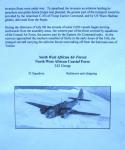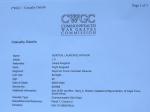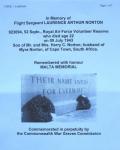-
Posts
13,225 -
Joined
-
Last visited
-
Days Won
22
Content Type
Profiles
Forums
Blogs
Gallery
Events
Store
Everything posted by Mervyn Mitton
-
Brad - firstly, welcome to GMIC. Speaking personally, I think that this has a good chance of being genuine. The appearance looks right and there is wear on the button holes. I am surprised that there is no label - as Simon mentions, have a look under the inner leather band. I am sure other Members will comment. Mervyn
-
Whilst this looks like a Parker Field tipstaff - it isn't. They always engraved their current name - also the finial on the end is not their pattern. They always used one that had a pattern like the base of a shotgun cartridge. I suspect that one of it's previous owners decided to use leather to protect the gilt on the body from any further wear - splendid that you have removed it and shown the brass. Obviously it would have been nicer if there was an original engraving for it's use - however, many carriers never bothered. They knew who they were - and simply having a tipstaff gave great powers - so, the public at large showed great respect to the carrier. Should it have been someone with a Power of Arrest, and you resisted - that carried a penalty of 7 years transportation - extra to the sentence. I would date this from 1830 (William 4th) and for an insured value Pounds sterling - 400/500. More if you had a provenance - can you remember where you bought-it ? Thankyou for your kind comments on my book - it is over 28 years since I wrote it - and to my knowledge it is still the only one that covers all aspects of police collecting. I wish I could sign it for you - however, at nearly 77 my travelling days are over. Mervyn ps. Thankyou for telling me who you were - I thought it was a friend 'testing me out' - cheeky devils do that sort of thing...........
-
You have set us a challenge with your avatar - depdogcov - perhaps an abbrev. of 'Deep Dog Cover' ? We shall look forward to the uncovering ! Meanwhile, you are very welcome on GMIC. The head of the tipstaff has been cast in brass - gilded, which has worn. The Cross Pate (the double cross surmounting the Crown is correct and I would say this is off a Victorian or, William 4th. tipstaff. With regard to the shaft - this is not correct. I would say thay it would originally have had a brass body - although Scotland tended to use ebony. I would hazard a guess that the shaft has been damaged and been covered in leather. The end piece has a screw fitting and if it is hollow then probably the original body. You need to carefully lift the leather and see what is underneath - if Scottish it will be about 4 to 4.5 inches long (10/11 cm) Perhaps you could do a close-up of the brass endpiece ? Mervyn
-

Pre -1994 South African Police Uniform
Mervyn Mitton replied to ocpd71's topic in Police Forces of the World
Richard - welcome to GMIC. We have a lot of retired SAP members and I am sure one of them will be able to answer your question. Failing this I will contact some friends still serving. Mervyn -

My Early Police Days................. Part 4
Mervyn Mitton posted a blog entry in Mervyn Mitton's Blog
INTRODUCTION One of our Members kindly commented that the Tower Blocks at Hendon Police College - a photo was shown in Part 3 - have been empty for a number of years. With that being the case, why were they built in the first place ? The first home for the Metropolitan Police was Great Scotland Yard. This was on the Embankment of the River Thames - across the road from the Houses of Parliament. Before Scotland and England were joined in 1603 , when James the 6th of Scotland also, became King of England as James 1st. following the death of Queen Elizabeth 1st. - Scotland Yard had been the home and Embassy for the Scottish Ambassador. The building was rebuilt for the Met. by the famous architect , Norman Shaw , in the later part of the 19th Century and was re-named New Scotland Yard. This building is still in use - however, the name moved to the new building in 1966/67. When the planned move back to the Embankment takes place the name and the famous sign will be attached. With the Metropolitan Police first 'Marching Out' in 1829, the whole concept of having a large disciplined force in place over a big part of Central London caused great concern. Until that point only some 4000 Parish Constables, Beadles and Night Watch were in charge of over one million people. There was little communication between them and events in one Parish would not be known in another. The French Revolution and the oppressive policing by Napoleon's para-military forces caused fears in England that our New Police would act for the Government. This led to a number of crowd attacks on Constables of the 'New Police' - as they had become known. There was also constant bad publicity in the papers and from the pamphlets that used to be sold on the streets. (by Bob Marrion-Plan drawer H Div.) Quickly though, it was seen by the middle classes that this was a civilian orientated Force - and formed to keep them safe and the English way of life - preserved. TRAINING CONTINUES With only a thirteen week course there was an enormous amount of work to get through. The classes covered many subjects - the most being our knowledge of the Law , how we should question people , forms and statements etc.. I think the sheer volume of paper work daunted all of us. All of the above was then tested on us with staged incidents. Great Fun - if you weren't the one being tested. The class would be taken by your Sgt. to an area specially set-up for demonstrations. You might find two old cars pushed together as an accident scene. A man in civilian clothes (another instructor dressed-up) lying unconcious on the ground and behind the steering wheel of one of the cars a man slumped over. Our instructor might shout out - ' Constable Mitton, you're on duty, walk around a corner and find this scene - what do you do ?' We all did the same thing - PANIC ! But then training took over - we had been taught PRIORITISE - deal with any violence first - then assist the injured. Call for help - if required - and find witnesses. I walked over to the man on the ground - unconcious - and blood on left leg and on ground. You must remember that this was in the days before cell phones and police radios - which were just being introduced. Ask one of the crowd - there is always a crowd, even in Instr. classes - to run to a shop and call Police and Ambulance. Turn him on his side - make sure airways are clear and that he isn't bleeding to death. Then - to the man behind the wheel - drunk out of his mind and mumbling. Fine - ambulance is on the way - see if they think he needs hospital - or, if I can take him to Police station. Again, there was no Breathalyser at this time. I'm checking for witnesses and a distraught woman runs out of the crowd - 'Thank God I've found you Officer - my sister is having a baby'. PANIC - PANIC ! Where is she - is someone with her - has an ambulance been called ? While your'e sorting all of this out, there will be other staged incidents - and all the time notes are being kept on your handling of the situation and points given. Sometimes, I felt it was easier being a 'vagrant' on the bus....... There is nothing like this to give you better training and an understanding of your new job - I clearly remember , we all thought this was just to teach and test us. However, when you go on duty you quickly learn that real life is far more stressful and multiple events regularly happen. Because you are the man with the 'pointed hat' and the blue uniform you quickly find that most people standwell back and wait for you to do 'something'. You have only to see the pictures of the murdered soldier in Woolwich to see how the crowd formed a circle very well back. However, had a Constable been present, I am sure you would have seen him run forward with only a truncheon to 'do his duty'. I have gone into some detail with the training - ex-police and soldiers in the Forum, will nod knowingly - we have all experienced the pressure. Hopefully, others - and our Google readers will find it of some interest. Once again - please remember that things are different 47 years-on. TIME OFF FOR GOOD BEHAVIOUR The routine was varied with some outside trips. For one day the Class was attached to a regular Police Station and we were individually taken on patrol. I remember walking around Camden and thinking - 'I hope I don't get posted here " . My early instincts were to arrest anyone under 20 - but, the Constable walking me round said I needed a reason - more damn red tape ! The other interesting place we visited was the Met. Police Museum. This was above Bow Street - the Divisional Station, and had a wonderful collection of early Met. related historical items. When Bow St. was demolished the Museum was closed and the collection went into storage. The Museum has now re-opened and I understand has been very well done. Perhaps someone can tell us if it is open for visits - and if the answer is 'YES' - is there a contact number ? Recruiting doesn't always get the right people and next time I will tell you of some incidents that took place during my thirteen weeks. -
Alex - more amazing artistry. The difference it makes is truly 'life changing' ! We certainly have some special artists with-in the Forum. Mervyn
-
We will be announcing the Competition soon - Steve , did we agree that you would despatch the two prizes and I will send postage ? I have had many problems with my computer line - however, they finally traced it to a break in the no.2 line at the back of the house. When my emails wouldn't go through to you I was asking if you wanted the Sth. African helmet + a British and another SA one - as part exchange for a good British helmet showing a famous scene from WW2 - I would like it on display in the shop ? Mervyn
-

my room
Mervyn Mitton replied to rod g's topic in Great Britain: Mervyn Mitton's British & Colonial Police Forces
Rod - you continue to amaze us with the quality and variety of your collection. I would say that this must rank as one of the top Police Collections in the World - if specific to one Country. One of the things that stands out for me - is the quality and sensible use of local animals and fauna in the badges and their designs. Should not already have a book - then I would say that you are the ideal person to produce one on Australian Forces and insignia. Mervyn -

My Early Police Days - Part 3
Mervyn Mitton commented on Mervyn Mitton's blog entry in Mervyn Mitton's Blog
Interesting comments. The Chief Constables are appointed by their Watch Committees. Until recently when some autonomy was passed to the Mayor of London the Metropolitan Police came directly under the Home Secretary. The Commissioner wears the rank badges for a full general - as does the Ch.Insp. of Constabulary. The Dep. Asst. Comm. wears rhe badges that would be for a Lieut. Gen. in the Army*. Therefore, on a protocol level they will automatically be senior. Also, as Tom points out the Met. have 32,000 serving officers + some 15/20,000 civilian staff. The nearest in size that I can think of is the West Midlands Force - which is probably less than 5000 ? (* + a second star) The first Commissioners in 1829 were both appointed as Magistrates - this gave them the authority to call on other units. The tradition continued and with the Riot Act it was necessary for a Magistrate to read it publicly in front of the assembly. The Comms. were usually the only ones brave enough. Both the Comm. and the Dep. Comm. are still sworn-in - unless yet another tradition has been dropped. With regard to them being Police Officers - having come through the ranks they are most certainly Police Officers with a power of arrest. They would have attested on joining. Chief Inspector's of Constabulary ,may now have become a political appointment. My blog is set when I first joined and the one I saw on a visit wore uniform and the same badges as the Comms. Mervyn -

Australian Knuckle dagger - very rare
Mervyn Mitton replied to erikscollectables's topic in Swords & Edged Weapons
Eriik - I am by no means sure that this is Australian. The Broad Arrow and DD - probably for Department of Defence - indicate that this is British in origin. I know that Royal Marine Commandos carried them - the knuckle duster is not common. There are numbers and just below the DD is a small set that looks like RSF. This may be a unit - however, I can only think of the Royal Scots Fusiliers - and I don't know why they should need this pattern. Perhaps our Members will be able to help with ideas. Value wise - this is quite a rare pattern. I wouldn't be surprised if it didn't fetch in the several hundreds of pounds to a specialised collector. Perhaps you should contact one of the top London auction houses. Mervyn -

RAF - WW2 - KIA
Mervyn Mitton replied to Mervyn Mitton's topic in Great Britain: Orders, Gallantry, Campaign Medals
-

RAF - WW2 - KIA
Mervyn Mitton replied to Mervyn Mitton's topic in Great Britain: Orders, Gallantry, Campaign Medals
-

RAF - WW2 - KIA
Mervyn Mitton replied to Mervyn Mitton's topic in Great Britain: Orders, Gallantry, Campaign Medals
-

RAF - WW2 - KIA
Mervyn Mitton replied to Mervyn Mitton's topic in Great Britain: Orders, Gallantry, Campaign Medals
-

RAF - WW2 - KIA
Mervyn Mitton replied to Mervyn Mitton's topic in Great Britain: Orders, Gallantry, Campaign Medals
-

RAF - WW2 - KIA
Mervyn Mitton replied to Mervyn Mitton's topic in Great Britain: Orders, Gallantry, Campaign Medals
-

RAF - WW2 - KIA
Mervyn Mitton replied to Mervyn Mitton's topic in Great Britain: Orders, Gallantry, Campaign Medals
-

RAF - WW2 - KIA
Mervyn Mitton replied to Mervyn Mitton's topic in Great Britain: Orders, Gallantry, Campaign Medals
-

RAF - WW2 - KIA
Mervyn Mitton replied to Mervyn Mitton's topic in Great Britain: Orders, Gallantry, Campaign Medals











